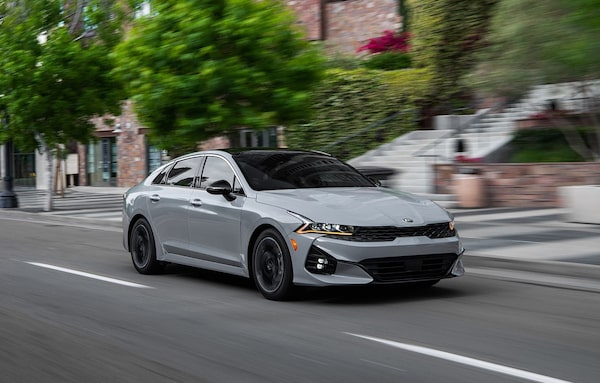
The 2021 Kia K5 replaces the Optima mid-sized sedan.Courtesy of manufacturer
Kia’s Optima mid-sized sedan will be replaced for 2021 by the K5 sedan – a similarly-sized but much sportier and apparently roomier car that will be turbocharged for better fuel consumption. The name for the all-new vehicle marks the start of a new naming system for Kia’s worldwide line-up.
The new K5 is “a vehicle that represents one of the biggest leaps forward between generations in recent automotive history,” said James Bell, Director of Corporate Communications for Kia Motors America, in a video presentation. “It’s such a dramatic departure that we had to give it a new name.”
When the K5 appears in Canadian showrooms this fall, it will be powered by a 1.6-litre turbocharged four-cylinder engine that makes 180 hp and 195 lb.-ft. of torque. This is a decrease of five hp from the current 2.4-litre engine, but an all-important boost of 17 lbs.-ft. The extra torque should make it more responsive than the current Optima.
This is the same turbo engine that is now available in the 2020 Hyundai Sonata. It uses new Continuously Variable Valve Duration technology (CVVD), which helps improve both performance and fuel efficiency. A more powerful 2.5-litre turbo four-cylinder engine that makes 290 hp and 311 lbs.-ft. will be sold in Canada “at a later date.” Kia says that larger engine will accelerate the car from zero-to-100 km/h in 5.8 seconds.
Both versions will use a new 8-speed automatic transmission, with an 8-speed “wet” dual-clutch transmission available as an option. An all-wheel drive version will also be available before this winter.
The current Optima is sold with a plug-in hybrid electric powertrain, starting at $44,000. Kia did not comment on whether that PHEV version will be continued or whether the K5 will also be offered with an electric powertrain. A spokesperson confirmed that “2020 will be the last model year for the Optima.”
“What we’re starting to see is that younger buyers want something different,” said Bill Peffer, Kia America’s vice-president of sales operations. “They’re not interested in driving the SUVs of their parents’ generation. The sporty, modern and bold K5 isn’t a vehicle you buy just because it’s practical – it’s a vehicle you aspire to own and drive.”
The K5 will be built on Kia’s third-generation N3 platform, which provides a quieter ride and allows for sportier suspension. Kia says it lets the vehicle “sit longer, wider and lower compared to its predecessor, giving it a low-slung profile.”
The new sedan has a wheelbase that’s 45 mm longer than the Optima, and an overall length that’s 50 mm longer. The car’s width is unchanged, but the overall height is 20 mm lower.
The K5 has a fastback profile with a long hood, to emphasize its sporty nature and incorporate some of the looks of the performance Stinger coupe. Kia calls the front a “tiger face,” with a thin, wide grille, and shallow headlights.
Many driver’s-assistance features will be standard, including lane-following assistance, forward-collision warning and collision-avoidance assistance. There’s even collision-avoidance assistance in a junction that’s available as an option, which helps hit the brakes when turning left if there’s an oncoming vehicle.
There will be three different trim levels, but prices won’t be announced until closer to the K5′s release in the fall. The current Optima has two trim levels, starting at $28,495 and rising to $1,500 above that, plus $1,695 for delivery and destination charges.
Stay on top of all our Drive stories. We have a Drive newsletter covering car reviews, innovative new cars and the ups and downs of everyday driving. Sign up today.
 Mark Richardson
Mark Richardson